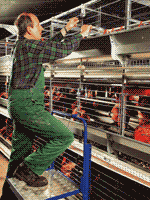What to consider when investing in enriched cages

In the second of our four-part series on enriched cages, Wendy Short quizzes a professional about points to consider for egg producers who are thinking about upgrading.
An EU-wide ban on conventional layer cages is due to come into force on 1 January 2012, leaving most egg producers facing a stark choice between non-cage systems and enriched cages.
Enriched cages, often referred to as “colony systems”, offer the birds increased space, as well as areas for nesting, scratching and perches (see table below).
Colony size?
Research by Big Dutchman has shown that 60-bird colonies offer the best compromise between producer management and bird welfare, according to Philip Dye, of the firm’s British distribution company, North Yorkshire-based Newquip.
Although a 60-bird version provides the same standard minimum requirement of 750sq cm/bird as a 20 or 40-bird system, the larger option effectively gives the hens more space in which to move around, he points out.
A 60-bird colony is also easier to manage when it comes to lighting.
“Our 3.6m housing is designed with a nest box at one end and a scratching area at the other. When installing the cages, the scratching area of one cage is positioned next to the scratching area of the adjacent cage. A dimmable fluorescent lighting tube is then hung vertically between the two, providing a light every 7.2m along the rows.
“Arranging the lighting like this means the nest box areas are darker, encouraging the birds to go in and lay, and the scratching areas receive the most light, which promotes natural behaviour.”
 |
The Directive lays down specific provisions that must be supplied by enriched cages. These include:
|
New build or adapt existing shed?
To date, 70% of Newquip’s customers investing in colony systems have chosen shed conversion as the best option, leaving just 30% favouring new build.
Mr Dye suggests that producers should evaluate existing buildings and ask themselves whether they are likely to last for the next 20 years. If the answer is no, they need to make a rough estimation of the likely cost of refurbishment.
The price of a brand new shed is estimated at £17-£30 per bird place, including fixtures and fittings. Meanwhile, the average cost of adapting existing housing is somewhere between £10-£14 per bird. Shed length can also influence the amount of investment required, with anything up to 125m (410ft) being considered economical. However, deep pit systems are not always the easiest to adapt for the installation of colony systems. Horizontal steel supports will have to be removed, leaving the building requiring additional support elsewhere.
Several other aspects should also be considered, when weighing up the advantages of conversion, says Mr Dye.
Normally a shed with colony housing will house a greater number of birds than the previously installed conventional battery cages, so the ventilation system may need to be upgraded, he says. Electricity and water supplies will also need to be modified. Furthermore, deep pit house floors are not always level, but a colony cage system will require a maximum fall of 100mm (3.9in) over the length of the building.
Colony height?
While acknowledging that maximising bird places is the key to profitability, Mr Dye advises against positioning cages too close to the ceiling.
“Your outside row should be no closer than 0.5m from the eaves on a pitched roof building. Any higher, and the ventilation system will break down and adversely affect performance.”
Three tiers is the maximum that can be installed safely without adding a catwalk or using inspection carts, he adds.
IPPC regulations
He advises that all colony systems should be designed to allow air dryers for manure to be fitted retrospectively, in case current Integrated Pollution Prevention and Control (IPPC) regulations are tightened to include farms with smaller numbers of birds.
This might incur an extra cost, but it will be much cheaper than stripping the system back to include air tubes at a later date. As well as capital and labour costs, sheds would probably be out of action for three months while the work was being carried out, says Mr Dye.
Mortality reduction
“The good news is that colony systems can reduce mortality levels by 2% points or more. The birds also eat slightly less, because they tend to congregate together at night to share bodily warmth,” says Mr Dye.
- Part 1 of this series introduces enriched cages and questions whether the sector has sufficient time to comply by 2012.
Want to know more?
- • The cage ban ruling relates to Council Directive 1999/74/EC, 19 July 1999. More information can be found at www.defra.gov.uk/animalh/welfare/farmed/layers/index.htm. A copy of the EU Commission report can be found at http://ec.europa.eu/food/animal/welfare/farm/laying_hens_en.htm
- • Details about IPPC regulations are included on the DEFRA website at www.defra.gov.uk/environment/ppc/envagency/pubs/index.htm
Supplier contacts:
- Newquip (Big Dutchman) – tel 01765 641 000
- Valli – www.valli-italy.com UK agent: tel 01743 718 717
- Hellmann Poultry – www.hellmannpoultry.com. UK agent: Equipment for Livestock Management, tel 01933 223 278
- Jansen Poultry Equipment – www.jpe.org UK contact: tel 01884 243 135
- Salmet International www.salmet.com
- Victorsson
- Vencomatic GB tel 01623 551 118
- Tecno, UK agent Spiro GB tel 01743 443 051
